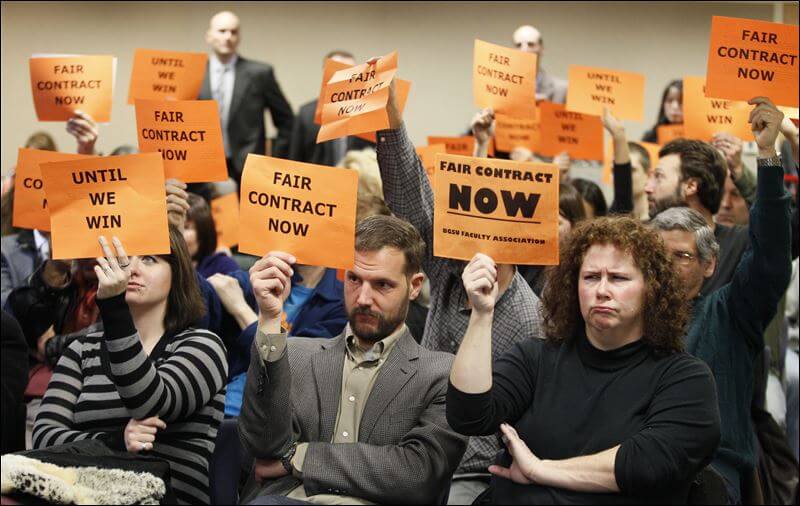For most college and university instructors in the United States today, teaching provides neither the job security nor income typically associated with middle class careers. That is because about 70 percent of all instructors are not eligible for tenure.
Not everyone thinks that the decline of tenure is a problem. It’s become commonplace to for critics of higher education to traffic in the myth that most tenured faculty are lazy and don’t have to work very hard. Other criticisms of the tenure system are that it privileges research over teaching, stifles change, or is simply antiquated. These critics suggest that its abolition would increase faculty productivity and student learning, as well as reward good teachers.
A look at the experience of college and university instructors who teach without the possibility of tenure suggests that whatever the problems with the tenure system, the new system replacing it is worse. The decline of faculty tenure coincides with the rise of the “gig economy” in the U.S.. As with so many different careers in the private sector that have been subcontracted out into temporary jobs in the last 30 years, instructors hired off the tenure track tend to have lower wages, worse benefits, less job stability, and fewer opportunities for promotion.
The result is that a new class of instructor has emerged. This class consists of people who hold a diverse array of positions: part-time lecturers (or adjuncts), full-time lecturers, graduate student teaching assistants, pre-doctoral instructors, post-doctoral instructors, visiting professors, and the like. Despite their many differences, they have a few things in common: short-term appointments, higher teaching loads and lower salaries than their tenure track colleagues. They are, as one organization puts it, “The New Faculty Majority”—though they have been the majority for decades, and now constitute something like a super-majority.
In what follows, I offer a synthesis of some recent reports on recent faculty demographics to describe the uneven nature of the decline of tenure, and identify the multiple experiences of faculty who teach off the tenure track. I hope this can open up room for thoughtful and constructive contributions to a discussion of various ways that faculty and their allies have responded to the decline of tenure and the lessons that can be learned from those struggles.
Decline of Tenure
According to a American Association of University Professors (AAUP) 2014-15 report, approximately three quarters of all college instructors in the United States worked without the possibility of tenure in 2013. This finding has been widely reported as indicating that three quarters of all faculty are off the tenure track. That is incorrect: it makes the common error of confusing all instructors (which include graduate student teaching assistants) with all faculty (who may sometimes be graduate students, but not serving as “assistants” to other faculty).

Still, tenure itself is clearly the exception rather than the rule for the majority of higher education faculty in the United States. The hiring of more tenure track faculty during the 2013-14 school, combined with a decline in the number of graduate student teaching assistants, appears to have slightly improved tenure density nationwide. But even if graduate students are considered separately from other faculty, as the chart above indicates, 34 percent of all college faculty in 2014 were on the tenure track, while non-tenure track faculty made up about 66 percent of all faculty.
The decline of tenure began decades ago. According to the AAUP’s 2006 “Contingent Faculty Index”, tenure track faculty haven’t made up a majority of all faculty in the U.S. since the late 1970s or 1980s.

When the use of graduate student instructors is factored into assessments of tenure density among higher education instructors, the decline of tenure appears even more stark. As the AAUP described it in its “Annual Report on the Economic Status of the Profession, 2015-16”:
Over the past forty years, the proportion of the academic labor force holding full-time tenured positions has declined by 26 percent and the share holding full-time tenure-track positions has declined by an astonishing 50 percent. Conversely, there has been a 62 percent increase in full-time non-tenure-track faculty appointments and a 70 percent increase in part-time instructional faculty appointments.
The leaders in replacing tenure track faculty with temps are private for-profit colleges and universities, and community colleges of all kinds. According to the AAUP, private for-profit colleges and universities have essentially abolished tenure altogether, while at least 80 percent of all community college faculty are ineligible for tenure.

The New Faculty Majority
The decline of tenure has produced a new class of faculty that, while heterogeneous, is fundamentally separate and unequal from their tenure track colleagues. Their shared identity as non-tenure track faculty is defined by their having less professional support, lower job security, and lower pay than tenure track faculty.
Within this class, there are significant divisions between so-called part-time and full time lecturers. As Figure 1 above indicates, 47 percent of all faculty in the United States, and over 70 percent of faculty off the tenure track are now “part-time” lecturers (also known as “adjunct” faculty). These faculty teach on contracts per term (semester/ quarter) or school year, and their teaching load at any given school may vary from one course per term to a “full load” of as many as three courses per quarter or five courses per semester. About 19 percent of non-tenure track faculty are full-time lecturers, who tend to teach a full load of courses every term on annual or sometimes multiyear contracts.
Though full-time lecturers are likely to receive basic professional support, part-time lecturers are not. A UCLA survey of higher education faculty in the 2010-11 school year found that less than half of all part-time lecturers reported having access to a shared office, telephone, or personal computer.
Because the hiring of lecturers and graduate student instructors is often informal, and their teaching contracts may be renewed at their employers’ discretion, instructors’ contingency translates into a lived experience of dependency and perpetual anxiety about contract renewals. A 2014 study found that non-tenure track faculty “perceive unique stressors at work that are related to their contingent positions”, and that these workplace stressors make them more predisposed to “depression, anxiety, and stress.”
The financial costs of teaching off the tenure track add to the psychological costs that come from having a temporary job rather than a stable career. The average salaries that faculty receive vary widely, making it difficult to compare across disciplines. But the AAUP estimates that the average annual salary for the lowest rank of tenure track faculty in the U.S. is about $67,000 per year, while the average annual salary for full-time lecturers is about $56,500 per year. Salaries for adjunct faculty are far, far lower: they range widely, from $1,800 to $5,300 per course. Colleges and universities thus pay their part-time lecturers—many of whom do not make anything close to $5,000 per course, and do not have full-time appointments— an average of $16,700 per year.

Non-tenure track faculty also receive fewer benefits than their tenure track colleagues. It is not uncommon for full-time lecturers and some part-time lecturers to have access to employer-supported retirement plans. But a 2010 survey by the Coalition on the Academic Workforce found that only 23 percent of part-time lecturers reported having access to health insurance through their academic employer. This is not accidental. According to the American Federation of Teachers, colleges and universities across the country responded to the passage of the Affordable Care Act in 2009 by limiting the teaching hours of their part-time lecturers in order to avoid having to contribute to their faculty’s health care.
Adjunct faculty are far more likely than full-time lecturers to seek outside employment to make ends meet. Somewhere between 20 percent and 30 percent of part-time lecturers teach at multiple schools to piece together a living, some of them taking on such heavy workloads that it can negatively impact the quality of their teaching. A number of those adjunct faculty who don’t find additional work struggle, with an estimated 25 percent of all part-time lecturers’ households receiving some form of public assistance from the federal government.
But while part-time lecturers may be paid poverty wages, not all are necessarily poor. Some consider their teaching “voluntary”, and don’t consider teaching as their primary career— though it is difficult to discern how significant this group is. A survey conducted by the National Center for Education Statistics in 2004 found that only 35 percent of part-time lecturers reported wanting full-time faculty positions. That study also found that half of all part-time faculty reported holding additional full-time jobs on top of their teaching jobs. This makes the most sense for professionals such as nurses, lawyers, and engineers who may teach one course per term for professional majors. In addition to working full time, some part-time lecturers rely upon others in their household to make ends meet, which helps explain the NCES finding that part-time lecturers had an average household income of over $91,000 per year.

More recent surveys, however, suggest that today’s adjunct faculty are less satisfied with their positions than they were a decade ago. A 2010 survey by the Coalition on the Academic Workforce found that “over three-quarters of respondents said they have sought, are now seeking, or will be seeking a full-time tenure-track position.” Similarly, a 2011 survey by UCLA’s Higher Education Research Institute found that less than a third of part-time lecturers considered their part-time status “voluntary” or desirable.
Looking Ahead
The decline of tenure has been uneven, and some faculty positions off the tenure track can be well paid or merely supplemental to instructors’ primary income. But the general decline in the salaries, benefits, and working conditions of college instructors in the United States remains unmistakable.
This is not a new issue. For over two decades, labor activists drawn from the ranks of graduate student teaching assistants and non-tenure track faculty have been documenting, analyzing, and contesting both the decline of tenure and the rise of a new class of hyper-exploited instructors. In in the weeks and months ahead, we plan to draw from some of these activists, and assess the campaigns they’ve fought, to facilitate our discussion of how professional associations might better represent and advocate on behalf of the new faculty majority.

Lecturer in Labor Studies at University of California, Los Angeles and California State University, Dominguez Hills.




3 Comments
Comments are closed.